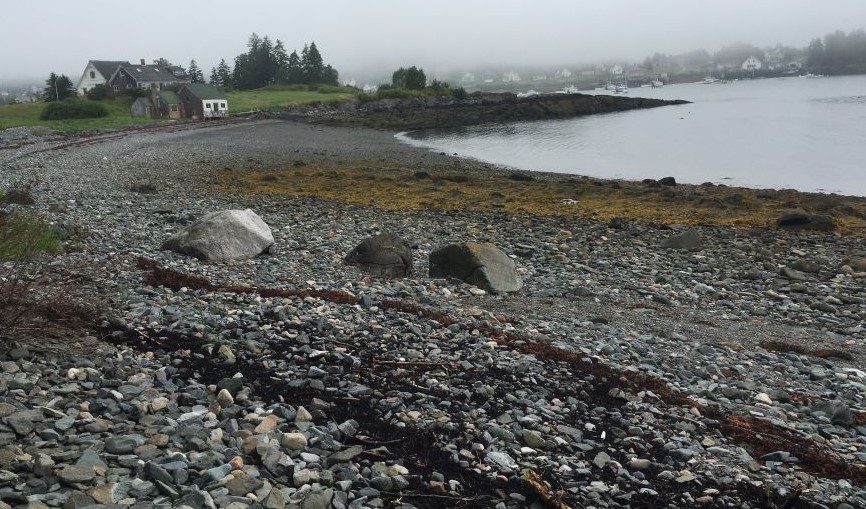The recent escape of 50,000 juvenile salmon from a fish farm off Cutler has again raised concerns about the risks posed to wild Atlantic salmon by net-pen aquaculture.
Fish farmers, though, say the incident points to the threat posed by large breeding colonies of seals, whose population they say is out of control.
On August 8, Cooke Aquaculture, in accordance with the state’s containment management system protocols, issued a report to the Maine Department of Marine Resources (DMR) of salmon escapes that occurred the previous day at two cage sites off Cross Island in Machias Bay.
The loss of the 50,000 small fish, weighing 200 to 400 grams each, represented 4.5% of the over 1 million salmon smolts at the two sites, which have a total of 44 cages.
Officials from the DMR visited the site the day after being notified by Cooke to verify what the company indicated in its report. Jeff Nichols, communications director for the DMR, says that the agency concluded it is highly likely that one or more seals were able to get past the predator netting and create a hole in the net pen, allowing fish to escape.
DMR staff also witnessed as many as 100 seals on a half-tide haul-out near the lease site. Others have indicated there are 300 to 400 seals in the area, according to the DMR.
Following the escape, divers inspected the nets to determine how the seals got into the cages. In accordance with farm management plans, the nets were confirmed to be properly tied, with a second layer of predator netting in place around the primary netting.
The company is assessing the entire site for other factors, ensuring all predator nets are tied and increasing the number of dives at each site. Cooke also is exploring enhanced netting options at its cages, including using netting with a stainless steel wire core as the primary netting.
“Based on Cooke’s report and our independent review of the gear, we consider this an isolated and unusual incident, and we are confident that Cooke has established a suitable corrective plan,” Nichols says. “However, DMR will continue to monitor this site as the plans are implemented.”
Seal abundance may be threatening ecosystem balance
“We have never experienced seal damage of this nature on our Maine salmon farms in the past,” said Joel Richardson, vice president for public relations for Cooke Aquaculture USA.
“However, seal takings in the fisheries and aquaculture sector are no different than a fox or raccoon burrowing into a chicken coop to kill farmers’ livestock. Preventative measures and barriers must be put in place by farmers to protect livestock, and government needs to responsibly manage predator populations.”
Richardson said it’s widely known in the maritime sector that seal populations throughout the Gulf of Maine, Atlantic Canada and Pacific Ocean have grown uncontrollably over the years by congregating “in massive breeding colonies.”
According to researchers, harbour and gray seals in Machias Bay each eat 15 to 20 pounds or between 6% to 8% of their body weight in fish per day.
“Fish harvesters, fisheries advocates and some scientists have suggested that the abundant seal population is throwing the ecosystem out of balance,” he commented. “Some fish populations, such as wild Atlantic salmon, risk extinction if current trends continue.”
Coastwide surveys in Maine from 1981 through 2018 indicate that gray seal numbers have been increasing, while harbor seal populations have remained steady or are declining slightly, according to James Gilbert, a retired professor with the Department of Wildlife Ecology at the University of Maine.
Gray seal pupping colonies in the state were first seen in 1994 in Penobscot Bay, with the larger seals moving down to Maine from Nova Scotia.
While both the Canadian and U.S. federal governments previously permitted licensed fisheries and aquaculture workers to kill aggressive seals that presented an employee workplace safety and/or equipment risk, that is no longer allowed, “given strict salmon product animal welfare rules by importing countries such as the U.S. who have a Marine Mammal Protection Act in place,” Richardson said.
“Regardless, several U.S. states including Washington and Oregon have an active seal/sea lion cull in place to help protect wild endangered fish from predation. All the fisheries and aquaculture sector can do is fortify and repair equipment when damaged.”
Risks posed to wild salmon
The incident has prompted reactions from wild salmon advocacy and environmental groups. Matt Dundas, campaign director at Oceana, an ocean conservation organization, said the escape “shows that salmon aquaculture in Maine is not risk‑free.”
“We can’t just put our oceans in the hands of the finfish aquaculture industry,” he said. “Maine’s waters are for everyone — from lobster fishermen and tourists who support Maine’s economy, to locals who call the coast home. We need to take a hard look at where these farms are headed and the rules around them.”
Neville Crabbe, executive director of communications for the Atlantic Salmon Federation, based in Chamcook, just outside of St. Andrews, noted there had been a great deal of concern about open net-pen salmon aquaculture on the West Coast after 260,000 non-native salmon escaped from a Cooke operation in Puget Sound in 2017, which led to the Washington state legislature last year prohibiting net-pen aquaculture in state waters.
Crabbe says there are significant escapes on the East Coast, too, and “the environmental risks are magnified here because they can interbreed with wild salmon. The hybridized offspring have lower survival rates than wild salmon, and interbreeding has been shown to contribute to population decline and collapse.”
Escaped farmed salmon can also spread sea lice or pathogens such as infectious salmon anemia to wild fish, he noted.
While Crabbe says that with the recent escape in Cutler the salmon were small “and less likely to be of sexual maturity, and they don’t do well in the wild, so the risk of interbreeding may be low,” he adds that the effects of any interbreeding are significant. “It’s a major concern of the Atlantic Salmon Federation.”
As for the risk of interbreeding posed by this incident, Nichols of the DMR said, “As far as wild Atlantic salmon, this escape event occurred well after the time frame when wild Atlantic salmon smolts migrate into the marine environment — April, May, June — so the escaped smolts are highly unlikely to interact with salmon that migrated out of Maine’s rivers earlier this year. This is also a time of year with higher density of predators, so that will also cut down the likelihood of survival.”
And Richardson noted, “There were no fish around the cages, which suggests they were eaten by seals in the vicinity following the breach.”
Concerning wild salmon recovery programs in the state, Nichols noted, “Atlantic salmon collected for broodstock from Maine rivers for the native salmon recovery program are genetically screened, which allows any aquaculture escapes to be identified and removed from the broodstock program.
“Therefore, if any salmon from this escape event do survive and return as mature adults, they will not be used as broodstock and therefore do not pose a risk to the genetics of our native Maine salmon.”
While the incident off Cutler may not pose much risk for any interbreeding with wild salmon, Crabbe pointed out that four escaped salmon have been detected this year in the Magaguadavic River fishway in St. George that were not from the recent escape in Maine.
However, no other escapes have been reported by fish farmers in the area. The ASF has been monitoring for escapes at the fishway since 1992, and every year they have found escaped fish even when there are no reports from salmon farmers of any incidents.
Since 1994, the number of escaped farmed salmon in the fishway has exceeded the number of wild salmon, with no wild fish detected during the past three years. In 2022 there were 59 escapees, though. The greatest number of escapees was seen in 1994, with 1,200 being detected, while there were only 131 wild fish.
“It’s proof that fish are escaping containment,” either in a small trickle or larger escapes, says Crabbe. “They do occur all the time. There have been tens of millions of escaped fish” since the salmon farming industry began in North America, he said, noting that the estimate has been peer reviewed by scientists.
And those escapes are occurring in areas where wild salmon populations are threatened or endangered. The farmed salmon are bred “for industrial traits,” such as being risk averse to going after food, which could expose them to predation in the wild.
“The industry hasn’t demonstrated they can keep the fish in the cages.”
While land-based recirculating aquaculture systems, such as the one Cooke Aquaculture is developing at Bayside near St. Andrews, “do remove domesticated animals from the oceans,” Crabbe noted the ASF is presently concerned about any industry expansion plans at sea.
“There should be no expansion of the industry until they can prove” there will be no escapes. “That would alleviate a lot of our concerns.”
He does note the industry has made improvements to its net-pen systems to try to prevent escapes, “but we can’t envision any configuration of net pens where they could eliminate the risk of escapes.”
Sign up for the Downeast Monitor, a free newsletter produced by The Maine Monitor, to stay informed of what’s happening in Washington County.
This story was originally published by the Quoddy Tides, and is republished here with permission.







